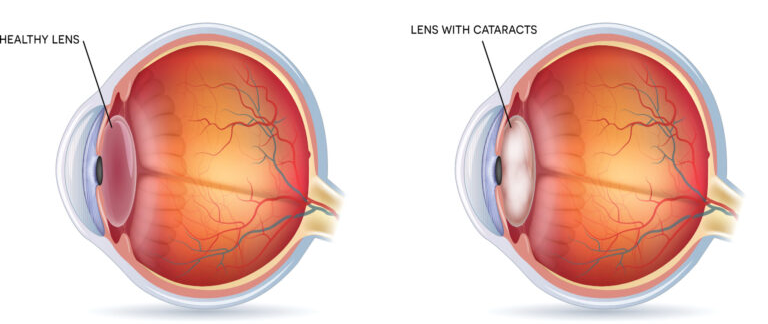Updated on October 21, 2024
Glaucoma vs Cataracts


Vision Center is funded by our readers. We may earn commissions if you purchase something via one of our links.
Millions of Americans suffer from glaucoma and cataracts. These conditions impair vision and can eventually lead to blindness.
While both lead to vision loss—if left untreated—cataracts and glaucoma are two distinct eye conditions. Each affects certain eye parts and is associated with different causes and symptoms.
Cataracts vs. Glaucoma: Similarities and Differences
Glaucoma and cataracts are different eye disorders with some similarities and differences:
How Glaucoma and Cataracts are Similar
Here's what glaucoma and a cataract have in common:
- Both are age-related. Your risk increases after 40 and will continue to increase as you age.
- More common in women. More women have glaucoma, and they represent 60% of all glaucoma cases combined11
- Similar symptoms. Both can affect one or both eyes and cause blurred vision, night blindness, and dim vision.6,7
- Both are preventable. Early detection can help your eye doctor keep them from getting worse.
How Glaucoma and Cataracts are Different
Here are the differences between glaucoma and a cataract:
- Prevalence. Black Americans have a higher risk for glaucoma. White Americans are at the most risk for cataracts.
- Affect different parts of the eye. Glaucoma affects the optic nerve, while cataracts affect the eye lens.
- Progression of symptoms. Cataracts are painless and develop slowly. Glaucoma can progress gradually with no early signs, or it can be painful and develop quickly.
- How they impair eyesight. A cataract blurs your vision and causes you to see in double. But glaucoma causes you to lose your eyesight.
- How soon you should get treatment. Cataract treatment can wait until it causes major problems. Glaucoma can be a medical emergency that needs to be treated right away.
- Available treatments. Surgery and laser treatment are your only options for cataracts. You can choose from surgery, laser treatment, prescription medications, and eye drops for glaucoma.
- Treatment outcomes. Blindness caused by cataracts is reversible with cataract removal, regardless of how bad it is. Glaucoma treatment doesn't reverse its symptoms but can prevent further vision loss.
What is Glaucoma?
Glaucoma is caused by optic nerve damage. It is triggered by high intraocular pressure (IOP) or increased pressure in the eye.

In a healthy eye, the lens projects light to the retina, which sends nerve impulses to the brain. Your visual cortex (located at the back of your brain) interprets them as images.
These impulses travel via the optic nerve. Damage from ocular hypertension can lead to vision loss and blindness.
Listen In Q&A Format
Glaucoma vs Cataracts
Vision Center Podcast
Signs and Symptoms of Glaucoma
Your signs and symptoms will depend on the type of glaucoma and the severity of your condition.
There are two main types of glaucoma:
1. Primary Open-Angle Glaucoma (POAG)
It affects 4 million Americans, making it the most common type of glaucoma. Symptoms include:1
- Peripheral vision loss
- Decreased visual acuity
Open-angle glaucoma causes gradual vision loss that begins on the sides. Unfortunately, most people won't know they have it until they lose their central vision.
2. Acute Angle-Closure Glaucoma (AACG)
Also known as narrow-angle glaucoma or acute glaucoma, it is a rare form of glaucoma with the following symptoms:2
- Severe eye pain
- Frequent headaches
- Blurry vision
- Nausea or vomiting
- Seeing colorful halos around lights
Angle-closure glaucoma causes noticeable symptoms that quickly develop. They can cause immediate damage to the optic nerve and lead to rapid vision loss.
What are Cataracts?
A cataract is a cloudy formation that appears on your eye lens. In a healthy eye, the lens should be clear.
The eye lens consists of proteins that break down with old age. This causes cataracts to form on the surface of your lens.

Signs and Symptoms of Cataracts
Cataracts develop slowly and will not affect your eyesight early on. As it progresses, you may experience:
- Blurry or cloudy vision
- Double vision
- Sensitivity to light or glare
- Poor night vision
- Seeing halos around lights
If you have a cataract, your color perception may change. Colors will appear faded or more yellow. You may also need to use more light when reading or performing activities.
Glaucoma and cataracts are among the leading causes of blindness in elderly Americans.3
Do Cataracts Cause Glaucoma?
Cataracts do not cause glaucoma. However, they can increase your risk for elevated eye pressure and glaucoma.
A cataract starts as mild yellowing and clouding of the lens. As it worsens, it becomes cloudier and thicker.
Cataracts can push the iris back to the trabecular meshwork — a spongy tissue that drains the aqueous humor. If this gets blocked, it prevents any excess eye fluid from draining.
This causes high pressure inside your eye, leading to angle-closure glaucoma. In these cases, you can undergo cataract surgery to reduce any symptoms of glaucoma and treat your cataract. However, you may still need additional treatments to restore normal intraocular pressure.8
On the other hand, glaucoma also does not cause cataracts. But certain glaucoma surgeries can put you at risk of developing cataracts.
Cataract and Glaucoma Treatment
Doctors treat glaucoma by reducing eye pressure. Some treatment options include a surgery called trabeculectomy and fluid drainage devices like tube shunts.
Even though cataracts and glaucoma are completely different eye diseases, it's possible to develop both conditions.
Your eye doctor will likely recommend cataract surgery and combine it with glaucoma treatments such as:
- Endocyclophotocoagulation. Uses a laser to reduce the pressure in your eye
- Glaucoma drainage devices. Involves implanting a tiny device in your eye to help drain fluid and reduce pressure
- Microshunts. Involves implanting a tiny tube in your eye to help reduce pressure and eliminate the need for medication
- Micro-invasive glaucoma surgeries (MIGS). Uses microscopic instruments to create a new drainage pathway for fluid in your eye
- Trabeculectomy. Involves opening a flap in your eye to create a new drainage pathway for fluid
Sometimes, cataract removal is enough to reduce eye pressure without glaucoma surgery.10
Summary
Cataracts and glaucoma are two eye conditions that can affect your vision. Different treatments are available for each condition.
If you experience symptoms related to either cataracts or glaucoma, visit your eye doctor immediately. This helps ensure you get the right treatment and prevent further vision loss.
In this article
11 sources cited
Updated on October 21, 2024
Updated on October 21, 2024
About Our Contributors
Mara Sugue, with a B.A. in Social Sciences, is a dedicated web content writer for Vision Center. She is committed to making eye health research accessible and understandable to people from diverse backgrounds and educational levels. Her writing aims to bridge the gap between complex vision health topics and readers' needs for clear, factual information.
Dr. Melody Huang is an optometrist and freelance health writer with a passion for educating people about eye health. With her unique blend of clinical expertise and writing skills, Dr. Huang seeks to guide individuals towards healthier and happier lives. Her interests extend to Eastern medicine and integrative healthcare approaches. Outside of work, she enjoys exploring new skincare products, experimenting with food recipes, and spending time with her adopted cats.

